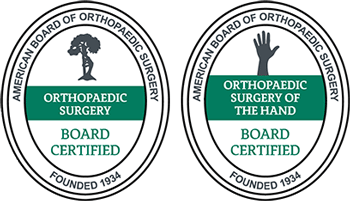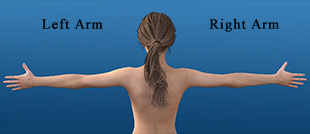Sprained Wrist vs. Torn Ligament
Your wrist is a supremely important joint, but it’s also susceptible to injury. More than a quarter of all sports injuries involve the wrist or hand. If you’ve experienced an impact or injury followed by wrist pain, you may be suffering from a sprained wrist or torn ligament. You should always speak with a doctor if you have sustained pain or severe swelling in your wrist, and at The Hand and Wrist Institute in Texas, we have years of experience with wrist and hand injuries. Below are some important things to know about how to treat a sprained wrist or torn ligament.
Contents
Understanding Wrist Injuries

person in blue and white long sleeve shirt by Towfiqu barbhuiya is licensed with Unsplash License
Your wrist is a complex construction that includes eight carpal bones, which articulate with the distal radius and ulna, and roughly 20 supporting ligaments. These ligaments are strong bands of fibrous tissue that stabilize the carpal bones while allowing for effective motion. Key stabilizing structures include the scapholunate ligament — connecting the scaphoid and lunate bones — and the triangular fibrocartilage complex, which helps support and stabilize the distal radioulnar joint and the ulnar side of the wrist.
An injury to the wrist can result in a sprain or torn ligament. If you’ve fallen, sustained a sports injury, or been in an accident and you’re experiencing wrist pain, you should see a doctor to determine whether you’re suffering from a sprain, torn ligament, or other injury.
What Is a Sprained Wrist?
A wrist sprain is an injury that occurs when the ligaments are stretched beyond their normal range, causing partial or complete tears. Symptoms of a sprained wrist include pain, swelling, tenderness, and bruising. You may hear a popping sound when the injury occurs. Sprained wrists are graded based on the severity of the injury.
- Grade 1 (mild): Slight stretching of the ligament, but no tearing
- Grade 2 (moderate): Partial tearing of the ligament
- Grade 3 (severe): Complete tearing or rupture of the ligament
What Is a Torn Ligament in the Wrist?
A torn ligament in the wrist is an injury where the ligament fibers are severely damaged and may be completely ruptured. This leaves the wrist extremely unstable, as the ligaments can no longer support the bones in the wrist. A torn ligament causes severe pain, bruising, and significant swelling. The wrist may feel loose or unstable, and you’ll typically have trouble moving the joint.
Causes, Risk Factors, and Diagnosis
A sprained wrist usually results from a fall onto an outstretched hand, which causes the wrist to twist or bend forcefully. A torn ligament is usually caused by a more serious injury such as a car accident, major fall, or high-impact sports injury. You may also tear a wrist ligament from anything that suddenly bends or twists the joint.
Both a sprain and a torn ligament are diagnosed with a physical examination and evaluation of your symptoms. Your doctor will often order tests to confirm and further evaluate the diagnosis, such as an X-ray or MRI. These imaging tests can identify associated fractures that may have occurred with the sprain or torn ligament so your doctor can thoroughly treat all aspects of the injury. While both conditions are associated with pain, bruising, and swelling, torn ligaments are more severe and produce notable instability in the wrist.
Treatment Options
A minor wrist sprain or minor torn ligament can be treated with the RICE method, which includes rest, ice, compression, and elevation. Your doctor will typically immobilize the wrist with a brace or splint. Nonsteroidal anti-inflammatory drugs are often used to minimize pain and swelling.
A sprained wrist or torn ligament may require surgical treatment in severe cases. Surgery is more common for a torn ligament than a sprain.
A sprained wrist can be treated with:
- Thermal shrinkage: A small probe applies heat to tighten the damaged ligament.
- Capsulodesis: A flap is created in the wrist joint and secured over the ligament to support healing.
- Tenodesis: The tendons are anchored near the joint with wires or sutures.
Torn ligaments can be repaired surgically through a reconstructive procedure in which the tendons are connected to or drilled through the carpal bones. This may include internal fixation devices such as wires. The ligaments may also be reconstructed with tendon grafts. Thermal shrinkage may be used in the reconstruction process as well.
Recovery and Prevention
A minor sprain may only need to be immobilized for a matter of days. A grade one sprain can heal fully in one to three weeks, while a grade two sprain usually takes three to six weeks. A grade three sprain may require several months for a full recovery. Range-of-motion exercises will help you regain full use of your wrist. Staying away from high-impact sports and properly taping the wrist joint during sports will help prevent further injury after a sprain.
If you engage in sports or other high-contact activities, you should wear proper protective gear, such as wrist guards and braces, to help prevent a sprain. Strengthening exercises can also minimize the chance of injury.
If you have a torn ligament, you may need to immobilize your wrist for a period of weeks for the ligaments to properly repair themselves.
Contact the Hand and Wrist Institute for Wrist Pain
Understanding the difference between common wrist injuries is essential for effective treatment and recovery. Sprained wrists and torn ligaments differ in severity, symptoms, and treatment approaches, so accurate diagnosis by a healthcare professional is essential. Our experts at The Hand and Wrist Institute can determine the appropriate course of action and prevent long-term complications such as chronic pain or instability. If you’ve suffered a wrist injury from a fall or need treatment for a torn wrist ligament, contact us today for an expert diagnosis and treatment plan.

























